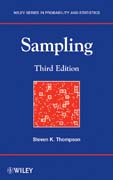
The Third Edition retains the general organization of the prior two editions,but it incorporates new material throughout the text. The book is organized into six parts: Part I covers basic sampling from simple random sampling to unequal probability sampling; Part II treats the use of auxiliary data with ratio and regression estimation and looks at the ideas of sufficient data, model, and design in practical sampling; Part III covers major useful designs such asstratified, cluster and systematic, multistage, and double and network sampling; Part IV examines detectability methods for elusive populations, and basic problems in detectability, visibility, and catchability are discussed; Part V concerns spatial sampling with the prediction methods of geostatistics, considerations of efficient spatial designs, and comparisons of different observational methods including plot shapes and detection aspects; and Part VI introduces adaptive sampling designs in which the sampling procedure depends on what isobserved during the survey. For this new edition, the author has focused on thoroughly updating the book with a special emphasis on the first 14 chapters since these topics are invariably covered in basic sampling courses. The author has also implemented new approaches to explain the various techniques in the book, and as a result, new examples and explanations have been added throughout. In an effort to improve the presentation and visualization of the book, new figures as well as replacement figures for previously existing figures have been added. This book has continuously stood out from other sampling texts since the figures evoke the idea of each sampling design. The new figures will help readers to better visualize and understand the underlying concepts suchas the different sampling strategies. INDICE: Preface to the Third Edition Preface to the Second Edition xiii Preface to the First Edition xv 1. Introduction 1 Part I. Basic Sampling 9 2. Simple Random Sampling 11 3. Confidence Intervals 29 4. Sample Size 35 5. Estimating Proportions, Ratios, and Subpopulation Means 39 6. Unequal Probability Sampling 51 Part II. Making the Best Use of Survey Data 65 7. Auxiliary Data andRatio Estimation 67 8. Regression Estimation 89 9. The Sufficient Statistic in Sampling 101 10. Design and Model 107 Part III. Some Useful Designs 115 11. Stratified Sampling 117 12. Cluster and Systematic Sampling 129 13. MultistageDesigns 143 14. Double or Two-Phase Sampling 157 Part IV. Methods for Elusiveand Hard-to-Detect Populations 171 15. Network Sampling and Link-Tracing Designs 173 16. Detectability and Sampling 185 17. Line and Point Transects 199 18. Capture-Recapture Sampling 233 19. Line-Intercept Sampling 245 Part V. Spatial Sampling 255 20. Spatial Prediction or Kriging 257 21. Spatial Designs 271 22. Plot Shapes and Observational Methods 275 Part VI. Adaptive Sampling 283 23. Adaptive Sampling Designs 285 24. Adaptive Cluster Sampling 289 25. Systematic and Strip Adaptive Cluster Sampling 309 26. Stratified Adaptive Cluster Sampling 323 Answers to Selected Exercises 339 References 343 Author Index 361 Subject Index 365
- ISBN: 978-0-470-40231-3
- Editorial: John Wiley & Sons
- Encuadernacion: Cartoné
- Páginas: 434
- Fecha Publicación: 14/02/2012
- Nº Volúmenes: 1
- Idioma: Inglés
